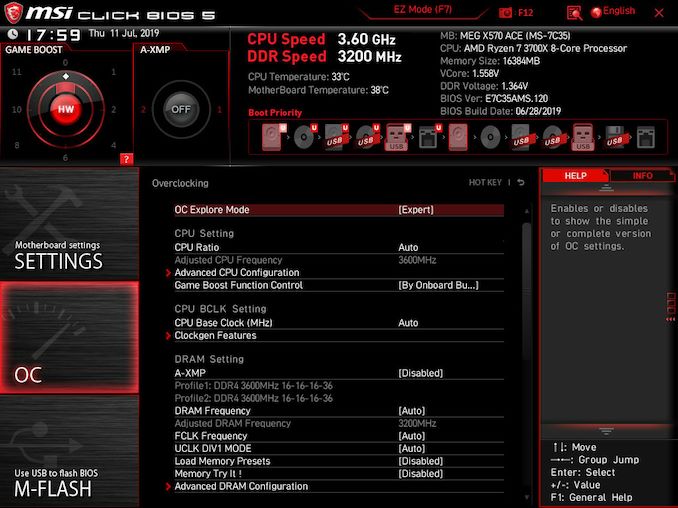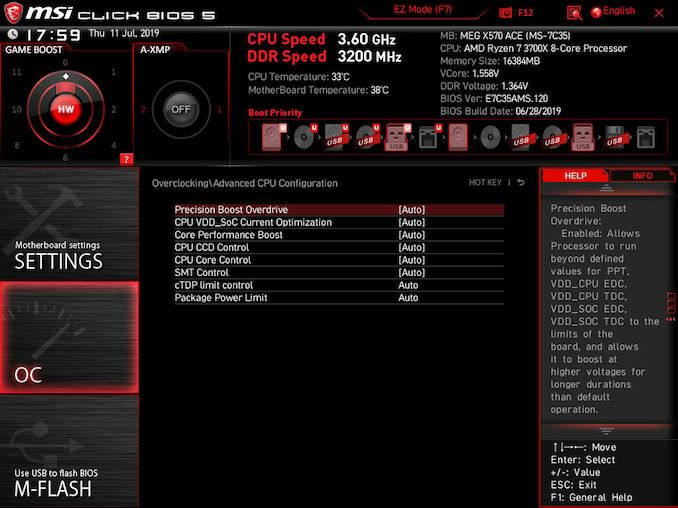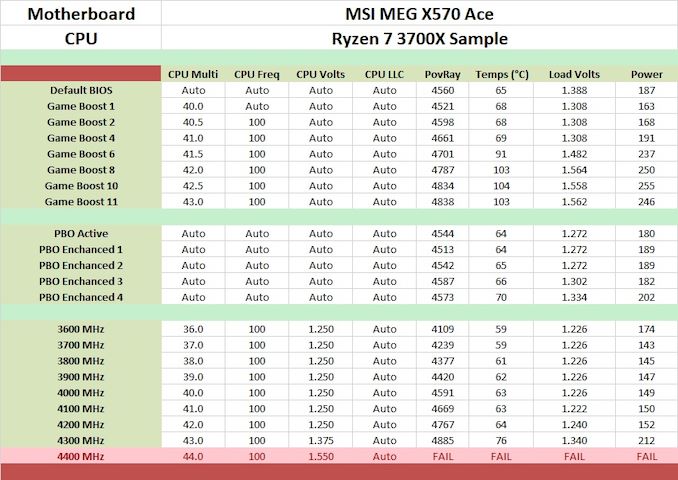The MSI MEG X570 Ace Motherboard Review: Ace in the Hole at $369
by Gavin Bonshor on July 18, 2019 11:00 AM EST- Posted in
- Motherboards
- AMD
- MSI
- AM4
- Zen 2
- Ryzen 3000
- X570
- MEG
- X570 Ace
- 3700X
- Ryzen 3700X
Overclocking Ryzen 3000
Experience with the MSI MEG X570 Ace
It's no secret that the general consensus of overclocking with the Ryzen 3000 series has been so far disappointing. Whether it be the limitations of the new 7 nm silicon or the insane temperatures that these processors run at when overclocked, or even at stock settings with the stock cooler, to unlock the full potential of these chips, better cooling methods such as premium AIOs and custom water cooling is needed.
Overclocking with the MSI MEG X570 Ace motherboard, there are three ways this can be achieved; within the firmware, with the simple, albeit effective tools inside the MSI Dragon Center application or with the comprehensive AMD Ryzen Master overclocking software. For the purpose of this review, we used the MSI Click BIOS 5 firmware which is very intuitive to use, and although this model was quite laggy, it still worked without issues. While the most commonly changed settings to overclock the processor include the CPU ratio which increases the frequency in increments of 100 MHz and the CPU VCore which increases the voltage pumped into the processor which not only generates extra heat but also increases power consumption.
In addition to the boost feature of the Ryzen 3000 processors, another AMD specific feature is called Precision Boost Overdrive or PBO. The three main variables that PBO works from including package power tracking (PPT), thermal design current (TDC), and the electrical design current (EDC). All three of these can be set within the firmware under the advanced section of the Precision Boost Overdrive menu, although MSI has included four different PBO profiles for users to select from. In addition to these are seven different Game Boost CPU overclocking profiles with each profile ranging from 4.0 GHz all cores up to 4.3 GHz all cores; these go up in increments of 50 MHz.
Overclocking Methodology
Our standard overclocking methodology is as follows. We select the automatic overclock options and test for stability with POV-Ray and OCCT to simulate high-end workloads. These stability tests aim to catch any immediate causes for memory or CPU errors.
For manual overclocks, based on the information gathered from the previous testing, starts off at a nominal voltage and CPU multiplier, and the multiplier is increased until the stability tests are failed. The CPU voltage is increased gradually until the stability tests are passed, and the process repeated until the motherboard reduces the multiplier automatically (due to safety protocol) or the CPU temperature reaches a stupidly high level (105ºC+). Our test bed is not in a case, which should push overclocks higher with fresher (cooler) air.
Overclocking Results
The 12+2 power delivery of the MSI MEG X570 Ace is one of the best we have seen from MSI in recent years and as a result, allowed us to manually overclock our Ryzen 7 3700X sample to 4.3 GHz with a set voltage of 1.375 V. Using the default load line calibration setting, this resulted in a load CPU VCore of 1.340 V which gives us a VDroop of 0.035 V in total. Of course, this can be alleviated by using a more aggressive LLC profile, but for the purposes of our testing, we leave this setting at auto. More voltage pumped into the CPU not only results in higher operating temperatures, but this also increases the overall power consumption.
Testing out each of MSI's seven Game Boost profiles did yield some interesting findings. First of all, each profile overvolted our Ryzen 3700X by a massive margin when you factor in what we achieved by using manual settings. Secondly, the three highest Game Boost profiles pumped insane amounts of CPU VCore in which in turn, made our 240mm AIO closed-loop cooler go into overdrive with temperatures in the triple digits. Outside of extreme overclocking, no Ryzen 3000 processor should be subjected to voltages of 1.562 V for a 4.3 GHz overclock on ambient cooling. Performance however was consistently higher with each of the profiles in our POV-Ray benchmark and by default with the Game Boost profiles, thermal throttling is disabled meaning that there is a trade-off between heat and performance. We also tested with PBO and found that performance was actually worse than the default settings, with MSI's four PBO profiles not really having much of an effect on performance; this leads us to believe for the most part, that PBO on Ryzen 3000 could do with a rework to make it more effective.













92 Comments
View All Comments
rocky12345 - Monday, July 22, 2019 - link
If you were replying to me I don't think I ever said what I had hooked up to the Sata ports. SO here goes I have a Samsung 860 Pro 512GB as my C drive and 3 4TB WD blacks hooked to the system as just pure storage and game drives. When I upgrade to a new platform I probably will go with a 1TB NMVe drive as my C drive and pick up 3 6TB WD blacks for storage.I may also installed a second cheaper 1TB NMVe drive in the second M.2 slot so can install most played games on that drive.
TheUnhandledException - Saturday, July 20, 2019 - link
How about the horrible lack of punch card reader support. 4 SATA is fine these days. The future is m.2 (or ideally also u.2 but that seems server only). I am glad that OEMs aren't wasting PCIe lanes putting in 6 or 8 or 10 SATA ports. If you really need 8 SATA ports then get an expansion card and connect all your drives to that.rocky12345 - Monday, July 22, 2019 - link
4 ports for most are fine even my own needs only need up to 4 ports since on my current system I have 1 Sata SSD and 3 Sata hard drives installed and got rid of the Blu-Ray drive a long time ago.I think the point being made was for this amount of money for the board it seems like they cut some of the features. I think I have seen other recent Ryzen boards with 6 sata ports maybe even 8 ports and cost less also. Right now I require up to 4 ports on my current system and have 5 ports free.
In my next build I will only need 3 ports because of switching to NMVe m.2 SSD drive but I do plan on getting 3 hard drives for large storage needs because SSD drives can not match the price to storage size yet of a regular hard drive. My plan just like last time I got my drives is to get the fastest possible drives on the market in the consumer segment which is the WD Black drives. I probably will get 6TB drives this time around and would like to get the 8TB drives but they seem to be hard to find right now so 6TB will have to do I will just get 3 of them to fulfill my storage needs.
Tomyknee - Saturday, August 31, 2019 - link
Thank you. Why does no one see this? This is the first new PCIe upgrade in a decade and people are fretting about 6gb SATA? Stay with a stinking X399 board if you are going to continue to use SATAAzurael - Friday, July 19, 2019 - link
Are you ever planning to do native EFI post time? I'm not sure how relevant BIOS-emulation boot is any more.I certainly haven't had CSM enabled for about 5 years - just leaving it on, even if you're booting in EFI mode, easily doubles POST time on most of the Gigabyte boards I've used in that period - and that's without enabling AMI Fast/Ultra Fast boot mode where it doesn't bring up unnecessary things like AHCI and XHCI controllers which aren't hosting a boot device and will have to be initialised by the OS anyway.
My current machine starts booting Windows about 2 seconds after I press the power button (which is much faster than any of the OEM machines I've observed booting in EFI mode and leads me to suspect that the relative differences between boards will be totally different in EFI mode.)
marcle - Friday, July 19, 2019 - link
How much noise does the chipset fan make? Can I use the X570 chipset in an audio production environment that requires a (virtually) silent computer?Right now I've got an i7-4771 with 84w TDP that's inaudible in an insulated case, and stays under 60C (usually well under) even at load.
How would the X570 fare in that situation?
DillholeMcRib - Friday, July 19, 2019 - link
Is there any reason why the vendors have gone from reasonably priced X470 boards to overbuilt Intel-level price gougers on X570?zer0hour - Friday, July 19, 2019 - link
Ridiculously priced motherboard.Qasar - Friday, July 19, 2019 - link
nope.. that would be MSI's godlike x570 board..zer0hour - Saturday, July 20, 2019 - link
That one is even more ridiculous.